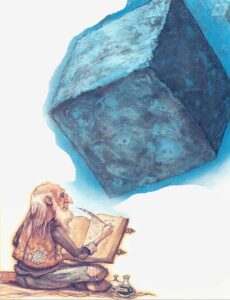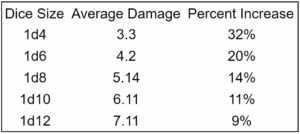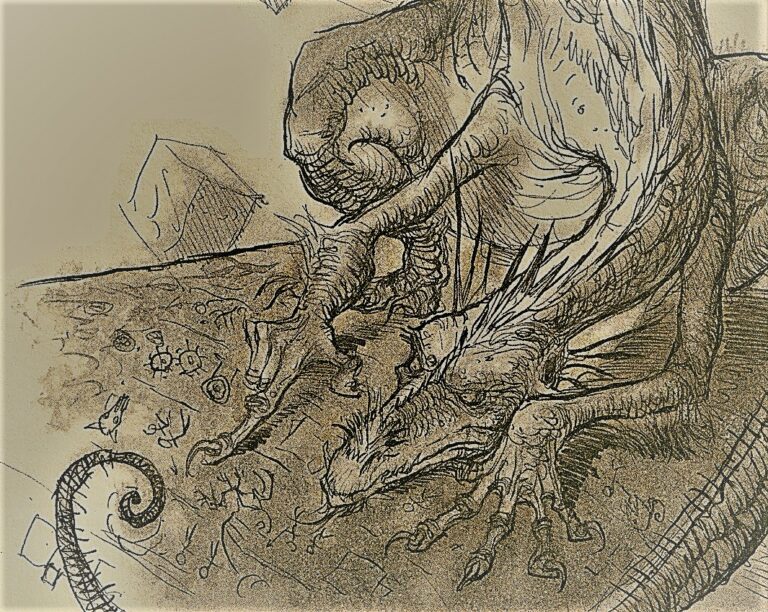Rules are elegant when they are intuitive, consistent, and easy to understand. That is, the rule reflects how we imagine something works in the real world, it always works the same way, and it is quick and easy to apply. DND’s “advantage” is an elegant mechanic, and its widespread use in place of more complicated rules has greatly increased the popularity and accessibility of the game.
Exploding dice, a staple of the Savage Worlds game system, is another elegant mechanic. When rolling dice, if the maximum value on any dice is rolled, the dice “explodes.” Roll any such dice one additional time and add their value to the previous total. Any rerolled dice may also explode. For example, you roll 2d6 for damage and roll a 3 and a 6. You reroll one dice, getting another 6. You then reroll that dice, getting a 4. This brings your total damage to 3 + 6 + 6 + 4, or 19.
As in Savage Worlds, exploding dice does not make sense for ability checks in d20 systems like D&D. Success and failure are binary, meaning there are not different degrees or gradations of success, and the critical hit on a roll of natural 20 already makes the maximum roll feel special. And, intuitively, we don’t want any random Joe to be able to paint the Mona Lisa because his dice exploded.
 Damage is a different story. Exploding dice matches our conception of how damage should work--if you strike the right artery, even by mistake, you’re going to do a lot of damage.
Damage is a different story. Exploding dice matches our conception of how damage should work--if you strike the right artery, even by mistake, you’re going to do a lot of damage.
But exploding dice is not just an elegant mechanic. It’s also a fun mechanic that spices up a roll that has become fairly boring: the damage roll. When you’re a great weapon master with high strength and doing a lot of damage from modifiers, your damage roll never swings the outcome of the fight. For the damage roll, you don’t have that feeling of playing the lottery where, if the stars all align, you might come out way on top. You have that for the initial attack roll, but after that, the damage roll feels like a letdown.
Still, the question with introducing any new rule is this: is the additional complication -- the additional rule players must remember and the additional time it takes to apply -- worth the extra fun? In this case, the answer is a clear yes. That’s because the way DMs should have players calculate damage mitigates the additional complications of exploding dice. And if you’re not already handling damage this way, I suggest you try it, as you may find it speeds up your combat significantly.
Instead of having players roll damage after each attack and waiting until one player has calculated all damage before moving onto the next, the DM should have players roll and calculate damage for all attacks after the conclusion of their turn while the DM summarizes the situation for the next player. This is preferable because -- unlike the attack roll where the DM has to inform the player if his attack beat the creature’s AC -- the damage roll does not require the attention of the DM. Damage is merely a matter of the player figuring out the result and informing the DM.
Now occasionally there will be circumstances -- such as when a critical enemy is low on hit points and that creature’s death would change the following player’s decision-making calculus -- that require the DM to slow down and wait for damage to be calculated before moving on. But, generally speaking, the damage roll can be done offscreen. This means that the additional complexity introduced by exploding dice occurs offstage, making that player’s damage roll more exciting but not slowing play down for the remaining players.
One other reservation that DMs might have about introducing exploding dice into their game is that it sounds overpowered. Short answer: it’s not. The math below -- which lists the increase in average damage for different dice when they are given the exploding property -- shows that exploding dice actually gives a smaller benefit to damage than adding a single +1 to a weapon (and that’s without factoring in the +1 weapon’s bonus to-hit).

The impact of making a weapon’s dice explode, rather than adding a +1, is not neatly captured by average damage, however. That’s because the increase in damage is not dependable or uniform--one might go 9 rolls without getting any bonus, but on the 10th roll do more than double one’s maximum damage. This means exploding dice does not change the underlying math of DND encounters, but instead occasionally gifts players a welcome surprise. Note that the bonus provided by exploding dice decreases as the damage die increases. DMs should experiment with different sizes of damage dice to see how giving them the exploding property works in their games.
 I’ve given the mechanics and the math, but what about the fluff? In my game, the exploding dice property is an exclusive benefit of weapons forged from Baatorian Green Steel. Black with flecks of dull green, this steel is magically forged in the furnaces of the Nine Hells to maintain its micro-serrations despite continual use in the Blood War. These micro-serrations, if struck at the perfect angle, have the capacity to deal tremendous damage. Thus, while they are frequently enchanted with other effects, Baatorian Green Steel weapons are most remarkable for their occasional outbursts of unmatched carnage.
I’ve given the mechanics and the math, but what about the fluff? In my game, the exploding dice property is an exclusive benefit of weapons forged from Baatorian Green Steel. Black with flecks of dull green, this steel is magically forged in the furnaces of the Nine Hells to maintain its micro-serrations despite continual use in the Blood War. These micro-serrations, if struck at the perfect angle, have the capacity to deal tremendous damage. Thus, while they are frequently enchanted with other effects, Baatorian Green Steel weapons are most remarkable for their occasional outbursts of unmatched carnage.
If you give exploding dice a shot or have other feedback on my article, let me know on twitter @theplanardm.

Nice flavor to add to weapons made out of Baatorian green steel. Will try it in our planar games.